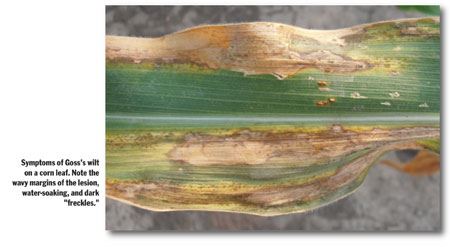Identifying Goss’s Wilt In Corn – More Than Just Immunostrips
URBANA, ILL.
Although Goss’s wilt has
not yet been detected in
any corn samples submitted
to the University of Illinois
Plant Clinic this year, the
disease may be present in the
state, especially in fields that
had severe Goss’s wilt in 2011
that were planted to corn
again. Goss’s wilt, a bacterial disease of corn
caused by the bacterium Clavibacter michiganensis
subsp. nebraskensis (Cmn), was detected
in several Illinois counties last season.
Identification of Goss’s wilt may require a multistep
approach, especially for those who are not
too familiar with the disease:
1. Evaluate affected leaves to determine
whether the symptoms and signs match those
of Goss's wilt. Leaf lesions will have a wavy margin,
and there will be some water-soaking. Dark
spots inside the lesions (often referred to as
“freckles”) also should be present. The affected
areas of leaves may also have a shiny appearance,
the result of exudates of the bacterium on
the leaf surface. Exudates sometimes resemble
sticky spots of maple syrup.
Have a plant diagnostic lab evaluate affected
leaves for bacterial streaming (ooze). A laboratory
such as the U of I Plant Clinic (web.extension.illinois.edu/plantclinic) will do this test, in
which affected leaf tissues are cut and placed
on a drop of water on a microscope slide and
checked for bacterial streaming. Its presence indicates
that the affected leaves have a bacterial
infection.

An immunostrip test may be conducted to determine
if the Cmn bacterium is present in the
leaves that were positive for Goss's wilt symptoms
and bacterial streaming. This test is available
from Agdia (Elkhart, Indiana), but it is
designed specifically to detect bacterial canker
in tomato, which is caused by a similar, but different,
bacterium – Clavibacter michiganensis
subsp. michiganensis. The immunostrip test
will also react to other species of Clavibacter, including
Cmn (the Goss’s wilt bacterium). False
positives are very possible when this is the only
step used to identify Goss’s wilt. For accurate
Goss’s wilt identification, it is extremely important
that you complete steps 1 (do symptoms
match?) and 2 (is bacterial streaming present?).
Δ
DR. CARL A. BRADLEY: Associate Professor of
Plant Pathology and Extension Specialist, University
of Illinois